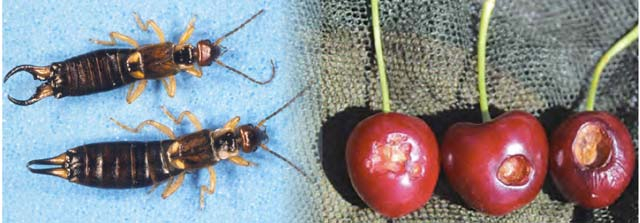European earwig has a very broad host range, feeding on a variety of horticultural and broadacre crops.
Earwigs can be particularly damaging in stone fruit crops including cherries where they feed on stems and fruit. In apples, earwigs do not generally attack the crop, and are considered an important beneficial insect.
Pest identification
Adult European earwigs are dark brown with yellow-brown legs and shoulders.
They are 12–24 mm long and have thin, segmented antennae with a pair of pincers at the rear of the body.
European earwig males have longer curved pincers and females have straight pincers.
European earwigs will feed on foliage, leaving irregularly shaped holes.
In fruit trees, most economic loss occurs from the earwigs feeding on the fruit causing shallow depressions that can be the perfect host for brown rot.
In cherries, significant damage can occur when earwigs feed on the stems of developing fruitlets.
Monitoring
Monitoring for European earwigs can include physically inspecting the fruit and leaves as well as trapping.
When inspecting fruit, look closely among fruit clusters as the adult earwigs will use these areas as shelter, particularly during daylight hours.
Earwig activity can also be monitored by placing sections of rolled corrugated cardboard in the tree canopy and checking once or twice a week for the pest.
Adult earwigs will use the cardboard rolls as shelter, making them easy to find. Observations of pest activity by monitoring can help with the timing for spraying and/or baiting programs.
Management
Cultural and physical
Practicing good farm hygiene will prevent the introduction and spread of European earwig.
Generally, European earwig will seek shelter during the day within the tree canopy and among fruit clusters, so keeping canopies open and thinning fruit to singles where appropriate will help reduce the potential for fruit damage.
Removing pruned branches from around the base of trees will remove alternative nesting sites. Removing drooping branches that are touching the ground will prevent earwigs from accessing the trees.
Reducing the height of weeds in the inter-row will reduce shelter options for the earwigs.
Biological
Currently there are no known natural predators of the European earwig.
Some birds and lizards will feed on earwigs, but this is unlikely to significantly reduce populations.
In apple and pear orchards, European earwig is considered a beneficial insect because it predates on woolly apple aphids.
Download the Orchard plant protection guide
See this article in Tree Fruit Jan 2022




















